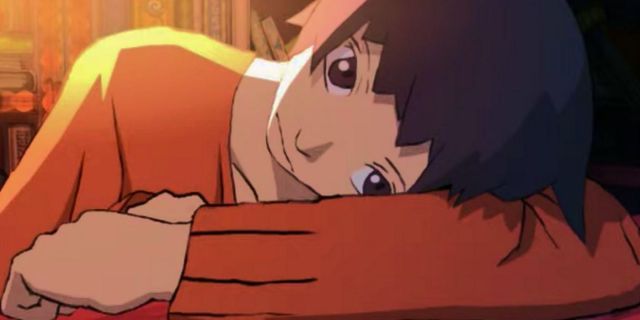Rain, the Little Girl, and My Letter (Ame to Shoujo to Watashi no Tegami) is a 6-minute short directed by Teikoku Shounen that was released in 2005. The ONA presents the tale of a young girl named Katari who dreams of becoming a novelist. At school, she decides to send a love letter to a boy that she’s started to fall head-over-heels for, but she is quickly rejected. While Katari is surprised by the sudden end to her romance, she attempts to learn from her experience and discovers that while she may not have touched the heart of the one she loved, her writing was able to move another.
While Rain, the Little Girl, and My Letter contains a tender story filled with more narration than many other shorts of this length, the art used to convey its messages is arguably sub-par. Although its backgrounds are detailed and evocative, the character designs are somewhat lacking and stand out for the wrong reasons within each scene. Despite this, the ONA manages to build a captivating protagonist who is instantly relatable.
The Plot of Rain, the Little Girl, and My Letter

Katari has spent all night preparing a letter for a boy in her class. While this boy is a “slow” worker and “nervous” when he speaks, Katari discovers that he is diligent in his studies, which makes her instantly fall in love with him. However, shortly after placing the letter in his locker, she is shocked to discover that it has been returned to her own. Unsurprisingly, Katari is angered that the boy hasn’t even bothered to send her a reply to the letter that she worked so hard to create. However, she takes the experience in stride, as she believes that her rejection will help improve her writing.
After returning home, she is tasked with looking after her parent’s bookstore while they attend a PTA meeting. A little girl begins to browse the collection of novels that line the shelves, despite there being a sign that clearly states not to do this. While Katari initially attempts to stop this customer from loitering, they eventually begin to strike up a conversation. Eventually, Katari realizes that the young girl has been reading her love letter, which brought her to tears. She explains that Katari’s ‘story’ was “heartwarming” and “well-written,” and even highlights that the boy she was writing to had indeed given her a response of “sorry.” Although Katari still didn’t receive the response she desired, she concludes that the experience was all worth it, as she managed to touch someone’s heart.
Rain, the Little Girl, and My Letter’s Animation Style

Rain, the Little Girl, and My Letter’s scenery has been beautifully crafted and manages to highlight a wide range of different areas of Katari’s village, school and home despite its short runtime. Small details within each scene will captivate an audience on first viewing and give them plenty of reasons to roll back the tape to see what they might have missed. Whether it’s slow-moving water trams, collapsible bridges or the greenhouse design of Katari’s classroom, Rain, the Little Girl, and My Letter’s world feels highly unique.
However, the ONA’s character designs leave much to be desired. While certainly charming in their own way, the characters appear far less detailed than their surroundings, are sometimes placed in strange postures and have eyes that are more cartoonish than the emotions they are supposed to convey. Nonetheless, this element does not distract from Rain, the Little Girl, and My Letter’s message and is largely a matter of personal taste.
Overall, Rain, the Little Girl, and My Letter is an engaging short about love and rejection that aims to show how even the most adverse situations can be looked at in a positive light. Katari’s narration is both charming and insightful as viewers witness her world and the emotions that she experiences. The ONA’s backdrops have been perfectly crafted and leave its audience wishing that each of these environments could be built upon in a future installment. While character designs are somewhat clunky, they maintain an element of uniqueness that is fitting with the rest of the work.















Leave a Reply